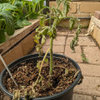Yellow puffy sores on tomato stems
shafjac
14 years ago
Related Stories

GARDENING GUIDES20 Favorite Flowers for Butterflies and Bouquets
Discover perennials and annuals that do double duty as butterfly magnets and versatile cut flowers
Full Story
HOUZZ QUIZHouzz Quiz: What Color Should You Paint Your House?
Is white right? Maybe dark blue-gray? Take our quiz to find out which color is best for you and your home
Full Story
DECORATING GUIDESThe Dumbest Decorating Decisions I’ve Ever Made
Caution: Do not try these at home
Full Story






shafjacOriginal Author
jean001
Related Professionals
Ashland Landscape Architects & Landscape Designers · Beavercreek Landscape Architects & Landscape Designers · Fort Lee Landscape Architects & Landscape Designers · Maple Heights Landscape Architects & Landscape Designers · Waterbury Landscape Contractors · Bloomington Landscape Contractors · Burlington Landscape Contractors · Farmington Landscape Contractors · Vallejo Landscape Contractors · Washington Landscape Contractors · Antioch Landscape Contractors · Winter Gardens Landscape Contractors · Kenosha Siding & Exteriors · Palatine Siding & Exteriors · Saint Petersburg Siding & ExteriorsshafjacOriginal Author
jean001
shafjacOriginal Author
petzold6596
hortster
jean001
mary_tomatoes
jean001